Aitchison 9x36
| Die 9x36 Version des Aitchison Monokulars vom Anfang des 20. Jh. hat wie das 12x36 einige Besonderheiten, insbesondere eine Irisblende. Der obere Deckel ist aus dunkelbraunem Bakelit und mit "x9 PROTECTED BY AITCHISON'S PATENTS" beschriftet. Die Unterseite des schwarz lackiertem Aluminiumgehäuses trägt die Nummer "216". Das Okularteil hat eine Drehfokussierung. Die vorhandene Augenmuschel aus schwarz lackiertem Messing wurde scheinbar nachträglich angefertigt und mit einer zusätzlichen konkaven Linse als Fixfokus festgestellt. Daher gibt es keine Bakelitaugenmuschel mit Dioptrienskala mehr. Die wahrscheinlich für militärische Zwecke gefertigte Augenmuschel trägt am Okularring die Beschriftung "83 Farringdon Rd. London E.C."; entweder die Adresse der Fertigungswerkstatt der Augenmuschel oder der Firma Aitchison zu dieser Zeit. Mit zwei Schrauben ist ein seitlicher Augenblendschutz angebracht, der sich wegklappen lässt und beim Einsatz an einer kleinen Schraube mit einer Einkerbung einrastet. (s. Foto) Wird der obere Deckel abgeschraubt (2 Schrauben), lässt sich das mit braunem Leder bezogene dreieckige Messinggehäuse nach oben hin abziehen und ein Aluminiumrahmen für das Porro-I-Prismensystem liegt frei. Die Prismen selbst sind an einem weiteren Trägerblech mit in einem Ring endenden Klammern montiert. Dadurch lässt sich das Glas leicht öffnen und reinigen. (s. Foto der Teile) |
Like the 12x36 the 9x36 version of this Aitchison monocular dating from the beginning of the 20th century has some special features, such as the iris diaphragm. The top cover is made of dark brown Bakelite marked "x9 PROTECTED BY AITCHISON'S PATENTS". The bottom plate of the leather covered housing is marked with number "216". The eyepiece can be turned for focusing. The black painted brass eye-cup in place was seemingly refitted, and adding a concave lens was intended as a fix-focus glass. So there is no Bakelite eye-cup with a dioptre scale left. The refitted eye-cup probably made for military use is inscribed "83 Farringdon Rd. London E.C." at its ocular ring. This might have been the address of the workshop where the eye-cup was made, or an Aitchison address at that time. A ray-shade is attached to the side of the eye-cup with two screws. It can be swung back or kept in place with a small slot stopped with another screw at the ocular rim. (see photo) When you unscrew the top cover (2 screws), you can pull off the triangular brass housing covered with brown leather. Now you can see the aluminium frame where the porro 1 prism system is mounted. The prisms themselves are clamped to another mounting plate. The metal clamps end with a ring. Thus the glass can easily be opened and cleaned. (see pics of the parts) |
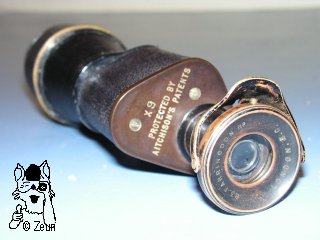
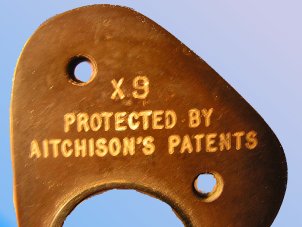
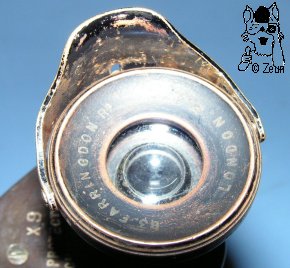
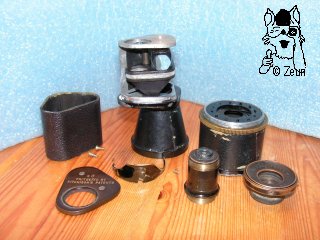
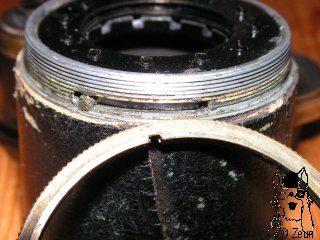
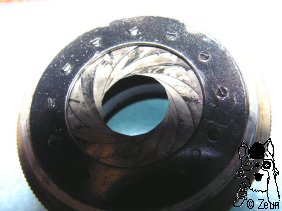
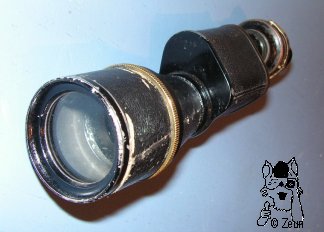
| Das Aitchison Monokular wiegt 377g, mit Orignalaugenmuschel 330g (Messingaugenmuschel 51g). Es ist 16,2cm lang. Das 19mm breite Okularstück ist 25mm lang und die Augenmuschel 36mm im Durchmesser. Die kurzen Seiten des 49mm hohen Prismengehäuses sind 44mm, die längere 51mm. Die Grundplattenseiten messen 46mm, 49mm und 53mm. Der konische Tubus verbreitert sich von 32mm auf 49mm und ist 43mm lang; der 38mm lange gerade Objektivtubus hat einen Durchmesser von 48-49mm. Der Blendenstellring ist 51 breit. Eine wohl spätere Version mit Nummer "530" (daneben eingeritzt "W.R. Young") ist am oberen Deckel mit "x9 AITCHISON & Co. MAKERS LONODN & LEEDS" beschriftet. Die Augenmuschel scheint aus einem mit Hartgummi überzogenem Aluminiumstück zu bestehen - eine Änderung, evtl. als Folge der häufig brechenden frühen Bakelitaugenmuscheln, oder eine Reproduktion. Der gerade Objektivtubus is ca. 2mm länger als beim anderen Modell. Am Gehäuse ist eine kleine schraube, die evtl. eine Trageriemnöse halten sollte. |
The Aitchison monocular weighs 377g. It is 16.2cm in length. The 19mm eyepiece is 35mm long. The eyecup measures 36mm in diameter. The short sides of the 49mm long prism housing are 44mm, the longer side is 51mm wide. The sides of the bottom plate are 46mm, 49mm and 53mm in length. The conical tube widens from 32mm to 49mm being 43mm long; the straight 38mm long objective tube has a diameter of 48-49mm. The iris adjustment ring is 51mm in diameter. A seemingly later version with number "530" (scratched next to it "W.R. Young") is marked "x9 AITCHISON & Co. MAKERS LONDON & LEEDS" at the top cover. The eyecup looks like a aluminium piece covered with hard rubber, probably a change of the early eyecups made of a easily breaking material – or it is a reproduction. The straight objective tube is about 2mm longer than the other one. The housing has a little screw that might have held a strap lug. |
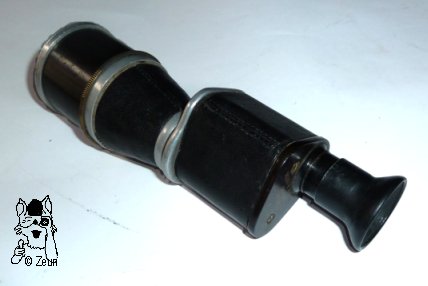
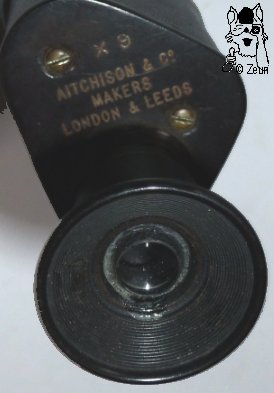
Fotos: Zeun

